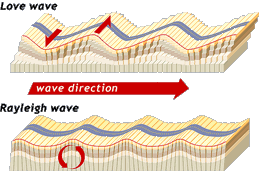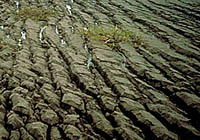
|
||||||||||||||||
|
|

|
||
|
|
|
|
|
Those of you lolling in the previously calm waters will notice waves sloshing toward you—and in all other directions from the diver, too. With all due respect to the jumper, the landing is a good metaphor for an earthquake. When the rocks along either side of a fault shift past each other, they send out energy in waves, much like the cannon-baller's sploosh rippled out. And like those waves that go through the pool, the waves of energy caused by the rupture pass through the earth and we feel them as an earthquake. An earthquake generates several different kinds of waves, each characterized by its speed and direction. You can get an idea of how these waves travel by picturing a Slinky (or better yet, making waves with your own Slinky, as described in our activity, Seismic Slinky). Waves that emanate from the site of the quake inside the earth are called body waves. The first of these are known as P waves, for primary or pressure. They are fast, traveling through rock at over 225 miles per hour (360 km/hr) and through water at about one-third that speed, pushing, pulling, and compressing the earth in the direction of their travel. Imagine that you have your Slinky on its side on a table. With one person holding each end, push your end forward and pull back. You’re exerting horizontal force on the Slinky, and you can see it traveling horizontally as parts of the Slinky compress together or spread apart. This is how P waves travel through the earth, moving it back and forth. An earthquake also causes secondary or shear waves, called S waves. These travel at about half the speed of P waves, but can be much more destructive. S waves move the earth perpendicularly to the direction the wave is traveling. Picking up the Slinky again, move it left and right, rather than forward and back. You’ll see that as the motion travels down the Slinky, it goes left to right, rather than forward and back. Now move the end of the Slinky up and down, watch the S waves travel, and imagine how a building would fare sitting atop the action.
P and S waves may seem
like shaky business, but the waves that really do damage are the ones that occur
when the energy of the quake reaches the surface of the earth. Rayleigh waves
churn over and under like rolling ocean waves; Love waves shake the earth from side to side. Love and Rayleigh waves, named after their discovers, are the ones often responsible for
making buildings collapse. Imagine yourself trying to remain standing while the earth was going through such contortions! To make matters worse, these waves can travel at
different speeds through different types of rock, bouncing back or changing
direction. In places with certain rock compositions, this bouncing will amplify the waves, which will then cause more damage.
|
||
|
|
||
Live Eye • Great Shakes • Quake Basics • Damage Control • Active Zone




